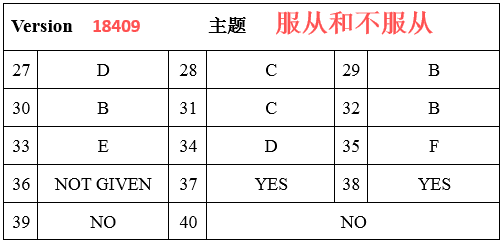gre阅读的分数占比较大,因此gre阅读能力十分重要,下面小编就和大家分享gre阅读能力提升方法介绍,希望能够帮助到大家,来欣赏一下吧。
gre阅读能力提升方法介绍
信息定位能力
所谓信息定位,也就是我们常说的gre阅读关键词的寻找。新gre阅读内容量非常大,在整个过程中,只有清晰的找到关键词,才能准确把握文章的主干。练习快速扫描,在文章或段落中定位并查找重要的事实和信息,包括主题信息、概念名称、日期、地点和数字等。经常反复地练习,可以提高阅读的速度和流利程度。
速读理解能力
对于gre阅读来说,文章中大量信息内容,就需要我们掌握好一个速读的能力。练习速读,训练通过快速浏览而非逐句细读发现文章主旨的能力。新gre考试阅读部分的选材,从文体角度看,大多是说明体和议论体的正式书面语文章。其语篇模式一般为导言、主题、支撑、结论四部分,并且每一段落的开头常可发现主题句。根据英语语篇的上述特点,阅读时注意文章的首尾段落以及每一段落的开始一、二句话,常有助于迅速发现所读内容的主旨。同时,注意语篇中一些具有语义提示作用的信息词和短语(见漫谈六),对于重要信息的快速查找和定位也是有帮助的。
研读整理能力
训练阅读除需要培养理解文章含义和增强查找信息的gre阅读能力外,还应适当注意所读材料的组织结构及写作手法,例如:该文章的组织方式可能是比较对照、分类、因果等,某个例子在阐述过程中有何作用。这有助于理解把握文章内涵和归纳概括内容提要。练习概括提要,区分主要与次要内容。对于描述过程的文章,可练习按顺序总结步骤,写出提要。若文章涉及信息分类,可尝试制作图表并将相关内容分类排列。虽然新gre考试并不要求自己设计分类图表,但这项练习有助于加强信息整理的意识,可以帮助考生更快适应此类题型。
GRE阅读题目特点
中心思想题
中心思想题是GRE考试中唯一带有主观色彩的题型,它考察你对文章大意和总体结构的把握能力。GRE阅读涉及的内容非常广泛,考古,生物,文学和社会科学几乎无所不包。那么,是否就没有技巧可谈了吗?绝对不是。
文章内容可能千差万别,但文章的写作方式却只有寥寥的两种,即记叙文和议论文。
记叙文是对某一件事,某一个现象或者某一个人的描述,即对客观事物的纪录和叙述,其中没有或者几乎没有作者自己的观点。记叙文有时间顺序和空间顺序两种组织形式。
而议论文是作者根据某一客观事物或观点发表自己的看法,并用例子或者理由来证明作者自己的观点。
根据文章的内容,议论文可以分成立论和驳论两种。而根据文章的组织形式,议论文可以有3种组织结构,分别为:从具体到概括模式,从概括到具体模式以及递进模式。
在GRE阅读中,没有真正的记叙文。也就是说,阅读文章基本上都是议论文,作者总是试图让你接受他的某一个观点。在证明自己的观点时,作者总是应用一些例子,即论据。
这些论据和论点之间的有机结合就成了典型的GRE阅读文章。掌握中心思想的技巧在于文章每个段落的第一句。标准化的考试决定了文章组织结构的严谨性,即条理清晰和结构完整。
条理清晰表现为写作模式不是具体到概括模式就是概括到具体模式,或者递进模式,而且承上启下的过渡词汇都出现在每个段落的第一句;结构完整表现 为内容的完整性和单一性,即每一篇文章都能向你传达一个而且只有一个有意义的观点或者论点,不会让你读后感觉到不知文章所云为何物。
复述题
复述题是最简单的题型,但也是GRE阅读部分出现得最多的题型。只要你能定位原文,问题就迎刃而解。题目问的内容中都已经在原文直接提到,只是用同义词或者不同的语言组织改写而已。
常见的改写方式有形容词与副词之间的改写,动词与动名词之间的改写。技巧在于寻找词根。复述改写题提问的是文章中的某个细节,如组织结构词(原因,特点),学科术语,行业术 语,比喻,符号或者具体的数字。只要你能准确定位,这些题都比较简单,因为只是对原文的复述或改写:
According to the passage/author...
The author states that...
The author mentions which one of the following as...
一般说来,这些题都会告诉你很直接的定位线索,如“在文章中的第几行”或者和文章结构密切相连的词或短语。你也许记得我前面告诉你的“跳过阅读理解文章中的细节部分而将重点放在文章的主题,范围和作者的用意上。”
这看起来好像和非常细节的复述改写题相矛盾。事实上,文章中有很多很多细节,而这么多的细节当中只有很少的一部分在以后问题中问及。奇怪的是这些被考 到的细节你很快就能在文章中定位,因为有一部分你在阅读时已经记住;问题会告诉你在文章中的哪一行;或者为了回答这些问题你必须自己找到这些细节.
暗示推理题
在你选出答案以前,其实你并不知道这是暗示推理题,你的概念或许只有细节题,即除了中心思想题以外所有题都是细节题。事实上,在真正做题时,你也不必事先判断它是属于哪一 类题型,我们将其归类的目的是为了让你对考试的题型有一个确切的把握。
也就是说,如果你碰到某一道“细节题”,顺利地将关键词定位以后,你仍然不能很快地确定到底是哪一个选项正确时,你不要灰心,因为有一种比复述题稍微复杂一点的题,即暗示推理题。
这一过程,我们的题型分类就起作用了,因为它事先给了你思想准备,即对未知的练习题有一个合理 的期待。但是,我们却可以通过暗示推理题的基本问法来事先判断它是否属于暗示推理题:
It can be inferred from the passage that...
The passage/author suggests that…
The passage/author implies that...
解密:暗示推理题是阅读中较难的题型。如果说复述题要脑子转一次弯的话,那么暗示推理题就需要转两次弯。,包括所有的美国人将这称为一个人的“intelligent ability”, 即智力。这种题在阅读题中出现的概率是0.3,每3道题中就会出一道,即大概每篇阅读出一 道。
列举题
列举,顾名思义,就是符合某种条件的几个例子,例子可以是某几个事件,动作,情况或者人物。列举题有两种形式,一种是列举非,它问你四个选项中哪一个原文中没有提及。
应对的办法仍然是定位原文,然后采用排除法,直至找到正确答案。第二种列举题要你在四个选 项种找出哪一个选项在原文中提及,应对的措施仍然是根据关键词定位。其实,列举题并不难,出现的概率也比较大,每篇阅读大概出现一题。
作者思路题
如果说中心思想题要你做的是归纳文章大意的话,那么在作者思路题中你所要做的是识别文章的组织结构。大意和组织结构构成了文章的框架。如果你能顺利地总结文章的大意,即中心思想,你也能顺利的求解作者思路题。
作者思路题包括段落用意和举例佐证两种。解题的 办法在于相信这样一个原则,文章的每一个词,每一句,和每个段落都是和文章论题有关 的,不是用来证明作者观点的论据就是作者要批判的论据。
逻辑题
在GRE的阅读理解中,有时也会出现像逻辑推理部分里的那些逻辑题。这些逻辑题包括类比和推理缺口题。有幸的是,这些逻辑题往往都比真正的逻辑题容易。只要你能顺利找到和归纳题干所描述的在文章中出现的推理,你就很容易发现这些推理(作者论点和论据)的缺口或者推理方式。
GRE阅读:Design-Engineering
Many objects in daily use have clearly been influenced by science, but their form and function, their dimensions and appearance, were determined by technol.ists, artisans, designers, inventors, and engineers—using non-scientific modes of thought. Many features and qualities of the objects that a technol.ist thinks about cannot be reduced to unambiguous verbal descriptions; they are dealt with in the mind by a visual, nonverbal process. In the development of Western technol.y, it has been non-verbal thinking, by and large, that has fixed the outlines and filled in the details of our material surroundings. Pyramids, cathedrals, and rock exist not because of geometry or thermodynamics, but because they were first a picture in the minds of those who built them.
The creative shaping process of a technol.ist’s mind can be seen in nearly every artifact that exists. For example, in designing a diesel engine, a technol.ist might impress individual ways of nonverbal thinking on the machine by continually using an intuitive sense of rightness and fitness. What would be the shape of the combustion chamber? Where should the valves be placed? Should it have a long or short piston? Such questions have a range of answers that are supplied by experience, by physical requirements, by limitations of available space, and not least by a sense of form. Some decisions, such as wall thickness and pin diameter, may depend on scientific calculations, but the nonscientific component of design remains primary.
Design courses, then, should be an essential element in engineering curricula. Nonverbal thinking, a central mechanism in engineering design, involves perceptions, the stock-in-trade of the artist, not the scientist. Because perceptive processes are not assumed to entail “hard thinking,” nonverbal thought is sometimes seen as a primitive stage in the development of c.nitive processes and inferior to verbal or mathematical thought. But it is paradoxical that when the staff of the Historic American Engineering Record wished to have drawings made of machines and isometric views of industrial processes for its historical record of American engineering, the only college students with the requisite abilities were not engineering students, but rather students attending architectural schools.
If courses in design, which in a strongly analytical engineering curriculum provide the background required for practical problem-solving, are not provided, we can expect to encounter silly but costly errors occurring in advanced engineering systems. For example, early models of high-speed railroad cars loaded with sophisticated controls were unable to operate in a snowstorm because a fan sucked snow into the electrical system. Absurd random failures that plague automatic control systems are not merely trivial aberrations; they are a reflection of the chaos that results when design is assumed to be primarily a problem in mathematics.
19.1. In the passage, the author is primarily concerned with
(A) identifying the kinds of thinking that are used by technol.ists
(B) stressing the importance of nonverbal thinking in engineering design
(C) proposing a new role for nonscientific thinking in the development of technol.y
(D) contrasting the goals of engineers with those of technol.ists
(E) criticizing engineering schools for emphasizing science in engineering curricula
19.2. It can be inferred that the author thinks engineering curricula are
(A) strengthened when they include courses in design
(B) weakened by the substitution of physical science courses for courses designed to develop mathematical skills
(C) strong because nonverbal thinking is still emphasized by most of the courses
(D) strong despite the errors that graduates of such curricula have made in the development of automatic control systems
(E) strong despite the absence of nonscientific modes of thinking
19.3.Which of the following statements best illustrates the main point of lines 1-28 of the passage?
(A) When a machine like a rotary engine malfunctions, it is the technol.ist who is best equipped to repair it.
(B) Each component of an automobile—for example, the engine or the fuel tank—has a shape that has been scientifically determined to be best suited to that component’s function.
(C) A telephone is a complex instrument designed by technol.ists using only nonverbal thought.
(D) The designer of a new refrigerator should consider the designs of other refrigerators before deciding on its final form.
(E) The distinctive features of a suspension bridge reflect its designer’s conceptualization as well as the physical requirements of its site.
19.4.Which of the following statements would best serve as an introduction to the passage?
(A) The assumption that the knowledge incorporated in technol.ical developments must be derived from science ignores the many non-scientific decisions made by technol.ists.
(B) Analytical thought is no longer a vital component in the success of technol.ical development.
(C) As knowledge of technol.y has increased, the tendency has been to lose sight of the important role played by scientific thought in making decisions about form, arrangement, and texture.
(D) A movement in engineering colleges toward a technician’s degree reflects a demand for graduates who have the nonverbal reasoning ability that was once common among engineers.
(E) A technol.ist thinking about a machine, reasoning through the successive steps in a dynamic process, can actually turn the machine over mentally.
19.5 The author calls the predicament faced by the Historic American Engineering Record “paradoxical” (lines 36-37) most probably because
(A) the publication needed drawings that its own staff could not make
(B) architectural schools offered but did not require engineering design courses for their students
(C) college students were qualified to make the drawings while practicing engineers were not
(D) the drawings needed were so complicated that even students in architectural schools had difficulty making them
(E) engineering students were not trained to make the type of drawings needed to record the development of their own discipline
19.6. According to the passage, random failures in automatic control systems are “not merely trivial aberrations” (lines 53) because
(A) automatic control systems are designed by engineers who have little practical experience in the field
(B) the failures are characteristic of systems designed by engineers relying too heavily on concepts in mathematics
(C) the failures occur too often to be taken lightly
(D) designers of automatic control systems have too little training in the analysis of mechanical difficulties
(E) designers of automatic control systems need more help from scientists who have a better understanding of the analytical problems to be solved before such systems can work efficiently
19.7. The author uses the example of the early models of high-speed railroad cars primarily to
(A) weaken the argument that modern engineering systems have major defects because of an absence of design courses in engineering curricula
(B) support the thesis that the number of errors in modern engineering systems is likely to increase
(C) illustrate the idea that courses in design are the most effective means for reducing the cost of designing engineering systems
(D) support the contention that a lack of attention to the nonscientific aspects of design results in poor conceptualization by engineers
(E) weaken the proposition that mathematics is a necessary part of the study of design
gre阅读能力提升方法介绍相关文章:
★ 高一英语期末复习方法介绍









 扫一扫支付
扫一扫支付


